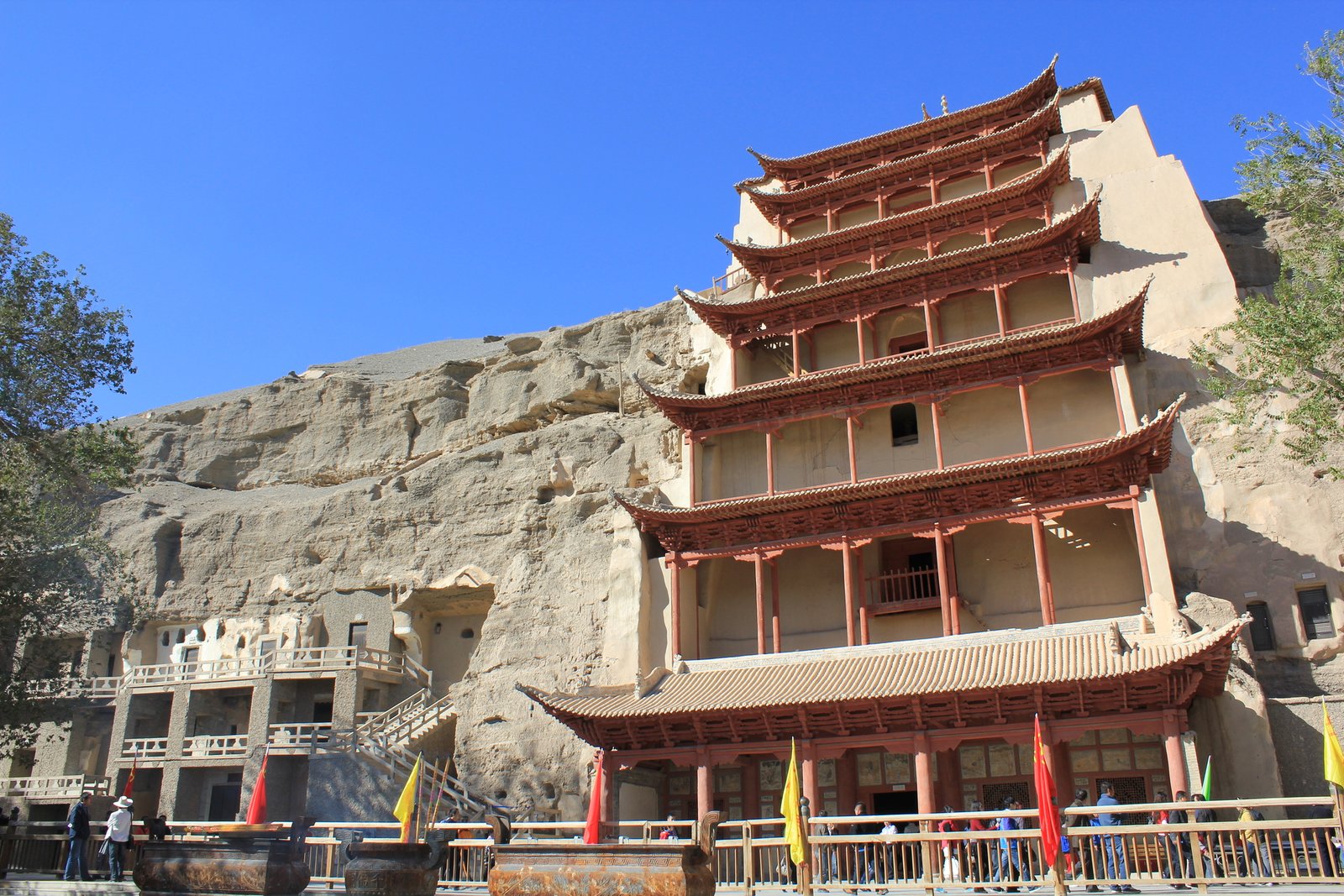Walking through the markets of Dunhuang, you’ll hear the sizzle of cumin-spiced lamb and smell roasted chestnuts. This desert city, once a hub for caravans, now shares its food heritage through every dish. Your first taste of Gansu’s traditions comes in the form of a steaming bowl of hand-pulled noodles, drenched in chili oil and rich soy sauce.
Silk Road food here is more than just food; it’s a conversation between different climates and cultures. The dry desert climate helps preserve slow-cooked mutton stews. Central Asian spices and Persian baking methods were brought by traders, adding to the flavors.
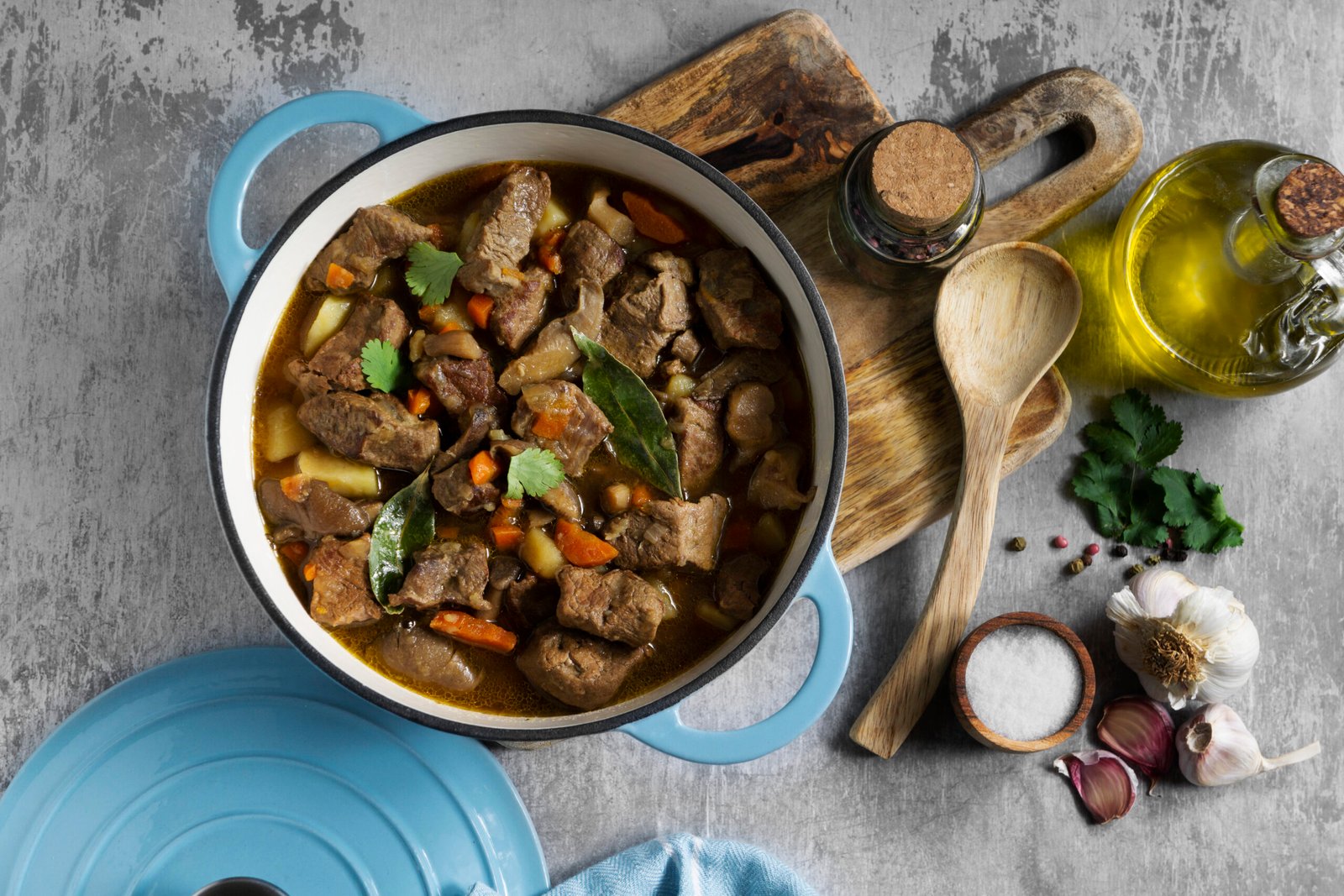
Trying Dunhuang’s cuisine is like tasting history. The tang of fermented vinegar in a soup reminds you the Tang Dynasty recipes. The crunch of sesame-studded flatbread brings back memories of caravanserai’s simple yet lasting dishes. It’s where ancient trade route cuisine meets today’s tastes, inviting us to enjoy traditions that shaped Chinese food.
Key Takeaways
- Dunhuang’s dishes reflect millennia of cultural exchange along the Silk Road.
- Hand-pulled noodles and preserved ingredients highlight adaptations to Gansu’s harsh environment.
- Local flavors blend Central Asian spices with Buddhist vegetarian traditions for unique textures and aromas.
- Markets and family-run eateries are living museums of Chinese food heritage.
- Each meal here connects travelers to a legacy of exploration and culinary innovation.
A Gastronomic Gateway to Ancient China
Walking through Dunhuang’s bazaars, you feel the history of caravans and spice routes. This oasis town’s food is a storybook of ancient travels. Every dish tells of journeys across continents.
Your exploration start with the mix of ancient Chinese cuisine and outside flavors. This blend is seen in its noodles, stews, and dried foods. Historical gastronomy here is more than theory; it’s a taste of history.
The Historical Significance of Dunhuang Cuisine
Dunhuang, a key Silk Road spot, mixed spices from Persia, grains from Central Asia, and Buddhist food rules. Its Dunhuang food history shows how traders influenced cooking. They used slow braises for long trips, dried fruits as snacks, and shared meals that last to this day.
Each dish is a mix of cultures.
How Desert Climate Shaped Local Food Traditions
Living in Gansu’s dry lands needed creativity. Here’s how:
| Ingredient | Adaptation | Legacy |
|---|---|---|
| Lamb | Lamb shoulder slow-roasted in earth ovens | Modern culinary adaptations use vertical rotisserie techniques |
| Millet | Parched into porridge for preservation | Now served as sweetened porridge with saffron |
First Impressions: Your Encounter with Dunhuang Flavors
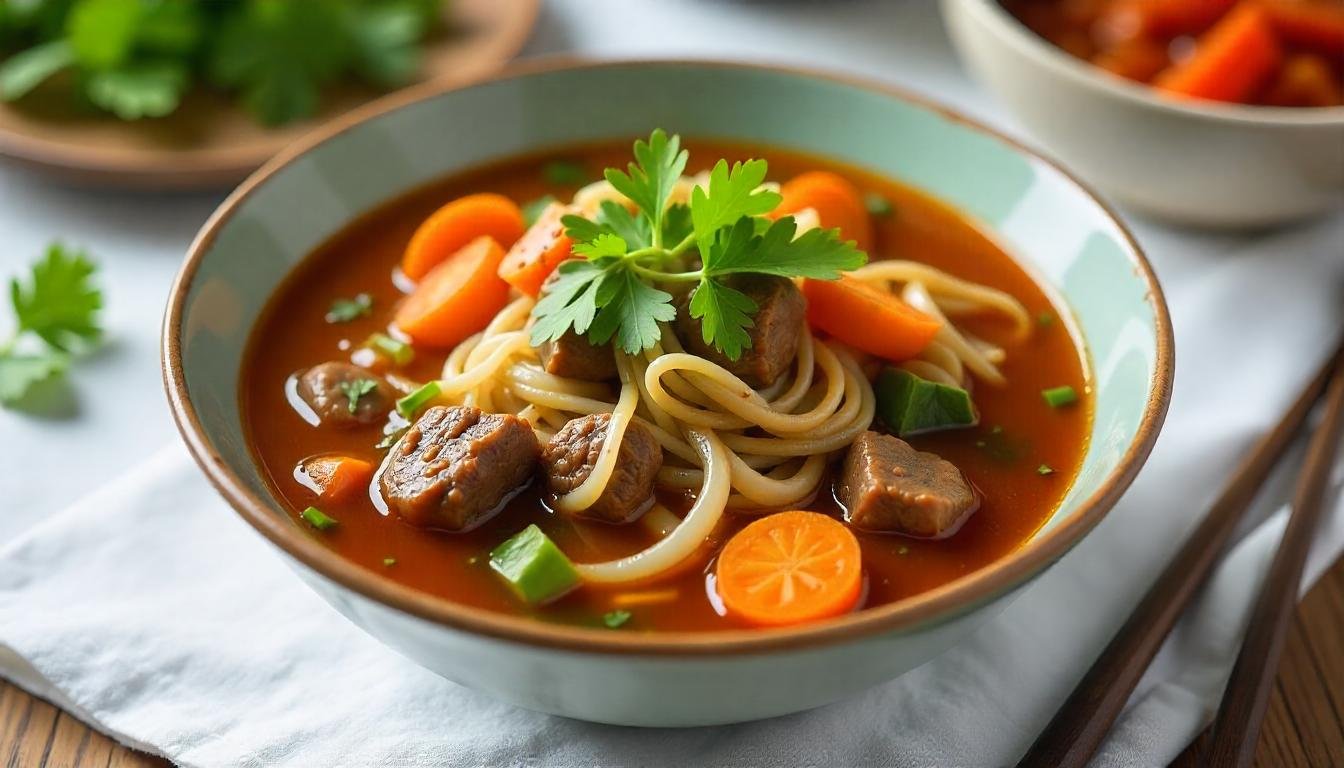
Your first taste of desert food traditions happens inside a family yurt. A bowl of laghman noodles reveals Dunhuang’s creativity with limited ingredients. What you experience is more than just food—it’s a hands-on lesson in history.
The Culinary Legacy of Silk Road Merchants
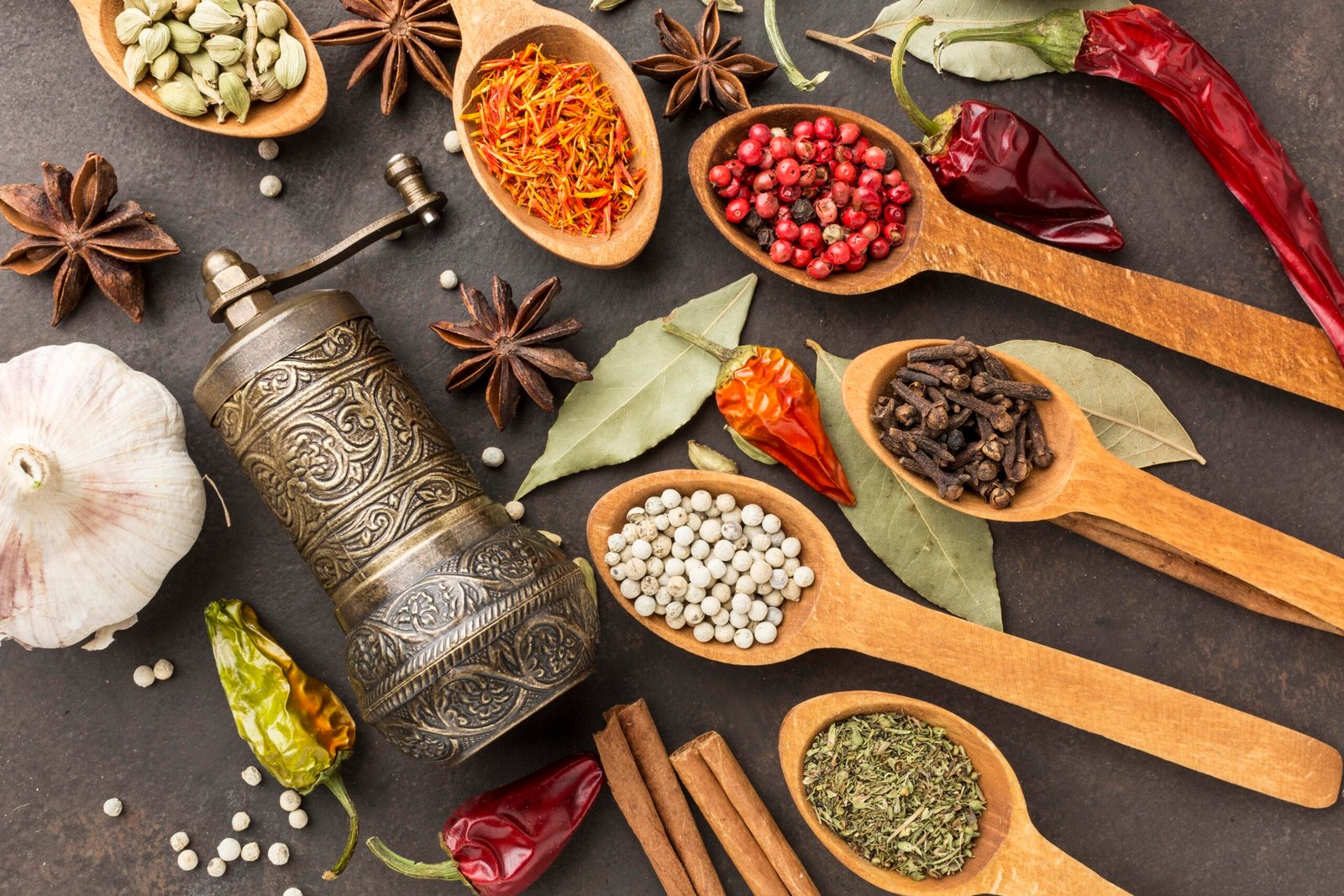
As you walk through Dunhuang’s markets, you follow the paths once taken by ancient Silk Road merchants. They carry more than goods—they bring flavors that transform local tastes. Their journeys infuse every dish with cultural food fusion, blending foreign traditions with the enduring strength of the desert.
Persian Influences on Dunhuang Cooking Methods
In a sun-bleached courtyard kitchen, a chef shows you how Persian food influence shaped slow-cooked lamb stews. Apricots caramelized with meat; rosewater perfumed rice—a mix of earthy and floral you’d never tasted before.
Central Asian Spices That Transformed Local Dishes
At a bustling spice stall, the vendor hands you a mortar. The warmth of Cumin’s warmth meets Central Asian spices—saffron threads, smoky black pepper. These rich aromas become the soul of noodle soups, revealing how ancient trade routes turn desert kitchens into living flavor labs.
Buddhist Vegetarian Traditions in Regional Cuisine
In a monastery kitchen, you learn about Buddhist vegetarian cuisine. Monks shows you how tofu, foraged greens, and roasted sesame pastes creates dishes so rich they don’t need meat. Their centuries-old recipes now fill modern restaurants, standing as flavorful wonders of cultural food fusion.
“Every bite here is a prayer and a journey,” says one monk.
From caravansary kitchens to today’s tables, Dunhuang’s flavors are a living mosaic of stories. These stories were carried on camelback and whispered between travelers.
Signature Dishes That Define Dunhuang’s Food Identity
Walking through Dunhuang’s markets, you’re hit with the rich aromas of local specialties. Your first bite of youmian—golden noodles bathed in chili oil and garlic—opens your eyes to a new world of flavor. Each noodle clings to its seasoning, revealing the mastery of chefs who’ve refined this craft for generations. These must-try Silk Road dishes are more than meals—they’re living stories of trade and cultural fusion.
Huangmen chicken, poached in desert herbs, captures the Gobi’s dry beauty. At a family stall, you see how mutton broth for yangrou paomo cooks for hours. It soaks up breadcrumbs like a sponge. “This dish remembers every firewood crackle,” a vendor says, while shaping dough into soft regional delicacies.
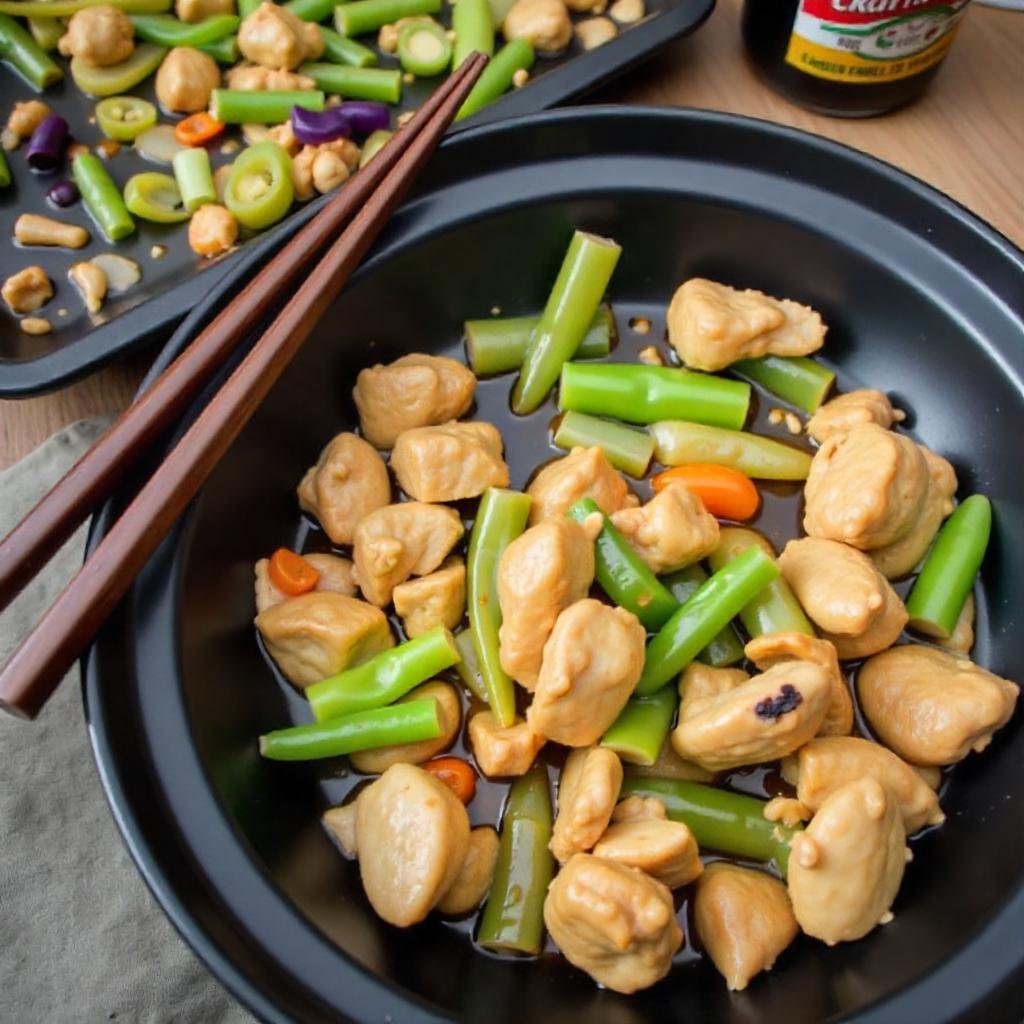
- Yangrou Paomo: Mutton soup with torn bread, symbolizing communal sharing.
- Huangmen Chicken: Poached in medicinal herbs, reflecting desert resilience.
- Lamb Kebabs: Skewers marinated in cumin, a legacy of Central Asian caravans.
“Every bite here is a chapter in our history,” Master Li says, whose family has kept recipes for centuries. His words stay with you as you sip goji-infused tea, a Silk Road tradition that connects past and present.
These dishes are more than tastes—they’re Dunhuang’s soul. From street vendors to secret spots, each regional delicacy invites you to taste centuries of crossroads cuisine.
Culinary Tour of Dunhuang (Gansu Province): An Insider’s Perspective
Your adventure in Dunhuang starts early, with the sizzle of grills and whispers of spice leads you to the Dunhuang food markets. These lively spots are more than places to buy food. They are the heart of Gansu cuisine.
Popular Food Markets Every Visitor Should Experience
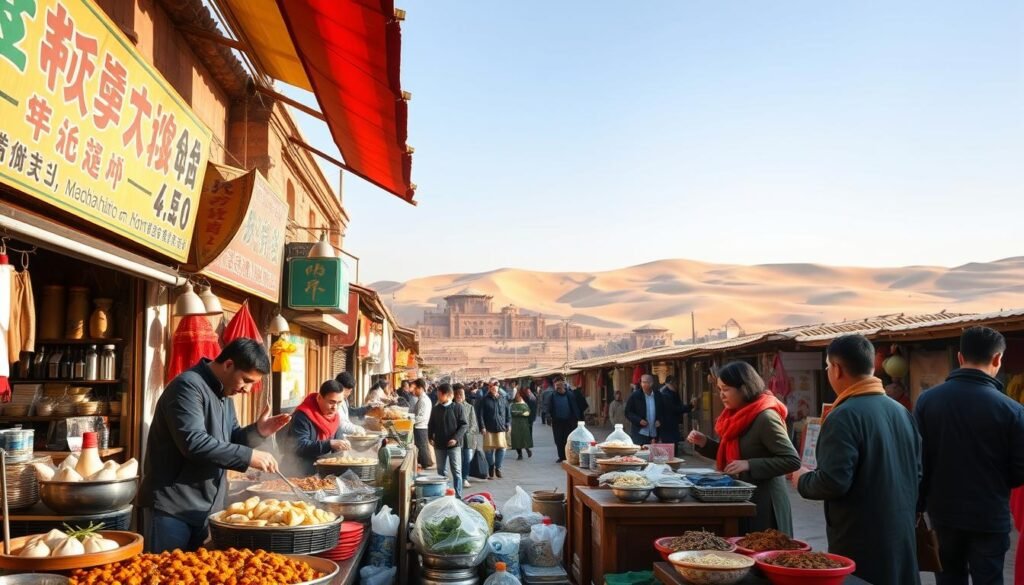
The Shazhou Night Market comes alive at dawn. You’ll find scents of cumin-kissed lamb, honey-glazed persimmons, and steaming noodle soups. Li’s Kitchen, a family business for three generations, serves up their famous
Hidden Gems: Family-Owned Eateries Worth Discovering
Hidden away, family-run Dunhuang restaurants keep traditions alive. At Grandmother Wang’s Noodle Shop, noodles are made by hand. A secret courtyard eatery in the old town offers desert-herb stews cooked in earthen pots.
“A good noodle is pulled, not cut,” she murmured, her hands spinning dough into strands.
The Art of Navigating Street Food Stalls Like a Local
Street food in Dunhuang is all about connection. Look for stalls where locals gather. Freshness is key, shown by how vendors toss scallions into hotpans. For those eager to learn, local food tours led by chefs reveal the best choices.
Every bite here is a story. It’s about caravans and emperors. Each meal is a journey through time and space.
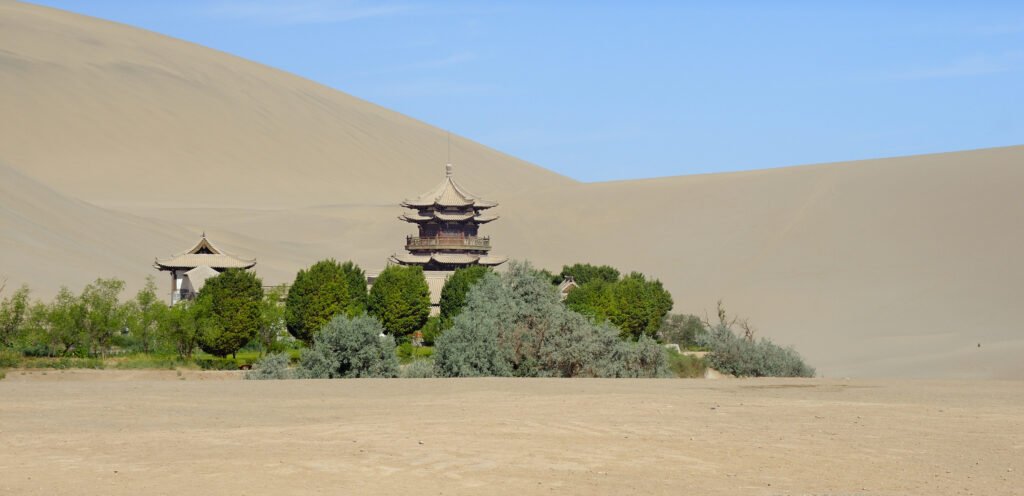
Noodle Craftsmanship: Why Dunhuang’s Hand-Pulled Noodles Surpass All Others
Your hands shake as you try to follow Master Li’s movements. The dough stretches and folds like it’s alive. As you watch him, you begin to see the beauty in every motion. His years of practice turn simple dough into a living form of art.
The Technique Behind the Perfect Consistency
Creating perfect noodles is all about precision. Here’s how the masters do it:
- Gluten development: The dough rested for 24 hours, getting stronger with each passing hour.
- Kneading rhythm: The dough was kneaded in a special way—three hard pushes, two folds, and one rest. This made it feel like rubber.
- Pulling mastery: The dough was pulled and folded until it became thin and silky. Each noodle showed the skill of the artisan.
Regional Variations of Noodle Dishes Within Gansu
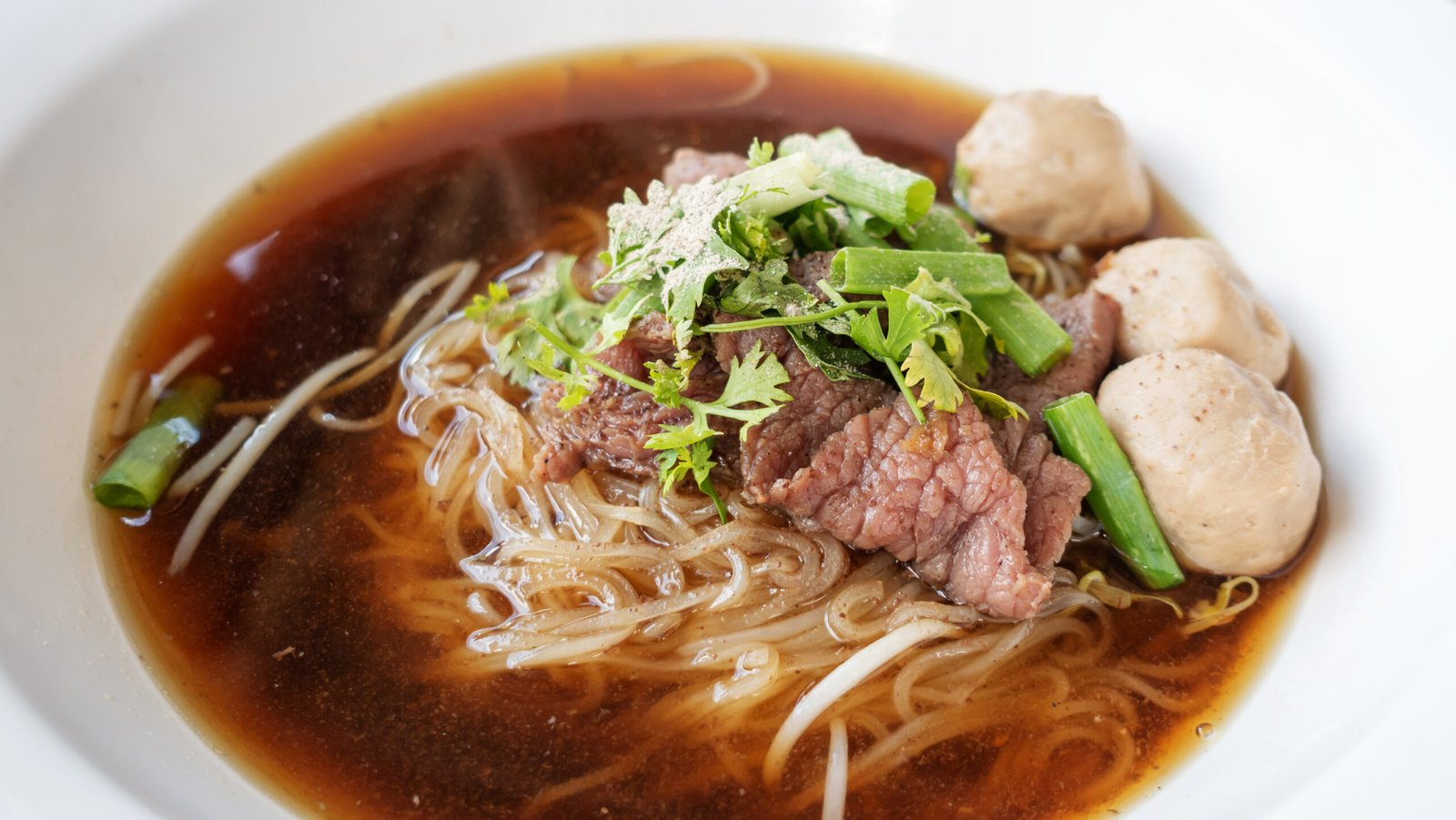
| Region | Signature Dish | Flavor Profile |
|---|---|---|
| Lanzhou | Beef Lamian | Clear broth, tender beef slices, wheat-sweet noodles |
| Dunhuang | Spiced Heartland Lamian | Smoky chili oil, cumin-kissed broth, chewy noodles |
| Western Gansu | Salt Lake Noodles | Pickled vegetables, mineral-rich broth from local springs |
Every bowl has a story. It’s about traders and desert people. Gansu noodles are more than food; they’re a map of the province’s heart.
Desert Oasis Dining: Unique Ingredients Born from Harsh Landscapes
Walking through Dunhuang’s morning markets, you see how the desert’s harshness creates amazing produce. Desert oasis ingredients like sun-kissed melons and wild wolfberries show the desert’s power. Farmers use oasis agriculture to grow Dunhuang local produce that thrives in tough conditions.
The soil and weather make these foods unlike any others. Imagine a melon so sweet it tastes like caramelized sunlight. Or noodles from drought-resistant wheat that crunch with earthy flavor.
Your favorite find is the desert-grown wolfberries—tangy-sweet and perfect alongside hearty lamb dishes. Farmers turn them into syrups or dry them for tea, proving that even in an arid environment, food can be rich, resourceful, and plentiful.
Even the desert’s toughest traits are strengths. Salt-tolerant plants like saltbush add a briny zing to salads. Wild herbs like black saxaul infuse oils used in Gansu desert cuisine staples like roasted legumes.
- Wolfberries: Sun-dried jewels in savory stews
- Desert Saltbush: Adds mineral depth to braised dishes
- Rain-fed mushrooms: Fleeting treasures after monsoon rains
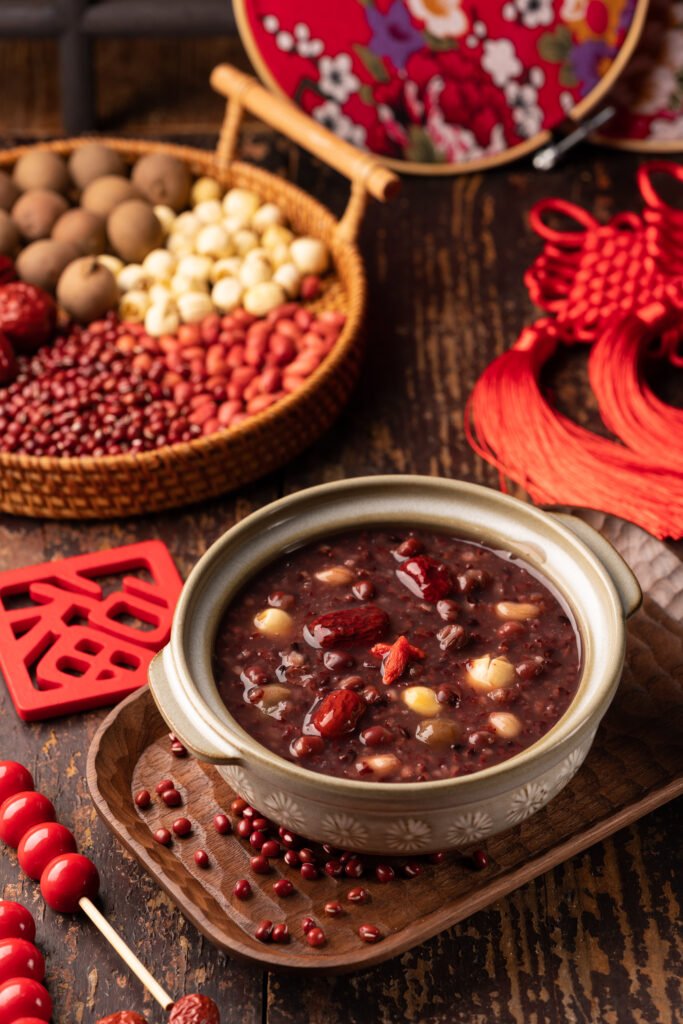
| Ingredient | Source | Signature Use |
|---|---|---|
| Wolfberries | Oasis farms | Infused syrups |
| Black Saxaul | Wild foraged | Lamb stew aromatics |
| Golden Mushrooms | Post-rain harvests | Earthy noodle broths |
Every bite here celebrates resilience. The Epicurean Escape culinary journeys show how these ingredients, born from scarcity, create dishes that reflect the desert’s harsh yet nurturing nature. In a bowl of hand-rolled noodles or a handful of sun-sweetened raisins, you taste the patience of generations turning challenges into triumph.
The Ritual of Dunhuang Tea Culture: More Than Just a Beverage
Your first taste of Dunhuang’s tea culture unfolds in a sun-drenched courtyard. Steam curls from bronze kettles set beneath the Mogao Caves. Here, Silk Road tea traditions blend Buddhist reverence with desert pragmatism. Every gesture in the ritual holds deep meaning, connecting you to centuries of mindful practice.
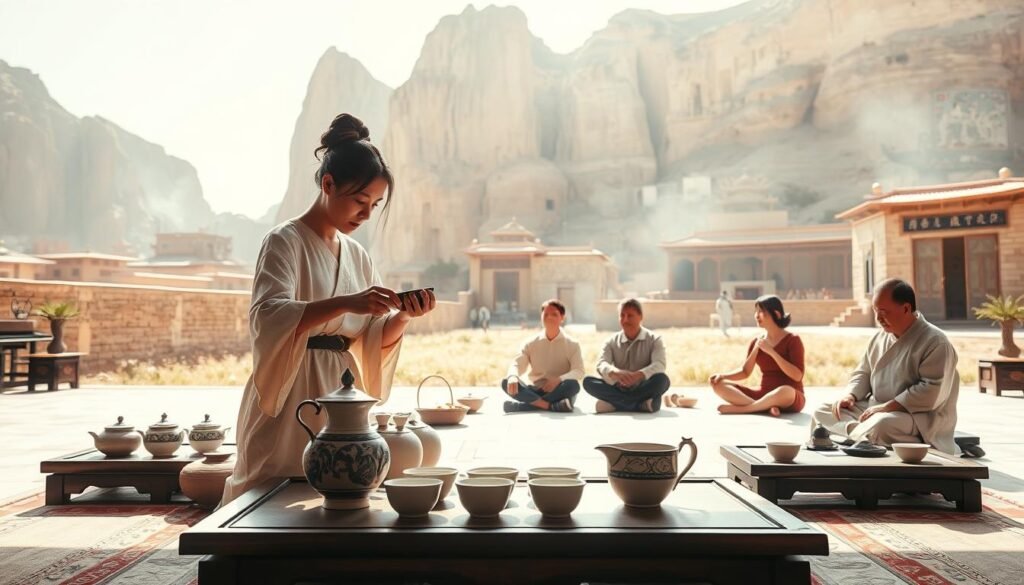
Traditional Tea Ceremonies and Their Significance
Master Li shows you how Gansu tea rituals turn drinking water into meditation. Chinese tea ceremony steps include:
- Crushing aged brick tea into a si jiu pot with salt and milk for herders
- Using clay bowls with cloud motifs from oasis kilns
- Boiling water precisely at 85°C to honor the delicate Longjing greens
Each motion reflects the patience needed to survive the Gobi’s harsh conditions.
Pairing Local Teas with Dunhuang Delicacies
Food and tea pairing here is like alchemy. At a family-owned cha ting (tea house), you learn to:
- Wash down lamb kebabs with smoky pu-erh to cut fatty richness
- Pair go Believe, the earthy dark tea with saffron-scented rice cakes
A monastery monk says,
“Tea is our silent translator—its warmth bridges the silence between bites and breaths.”
For those wanting to dive deeper, Epicurean Escape offers guided Gansu tea rituals. These honor both Silk Road history and modern tastes. This ancient mix of leaf and meal shows every sip is a journey through time and terrain.
From Ancient to Modern: How Traditional Recipes Have Evolved
Near the Mogao Caves, you find how modern Dunhuang cuisine brings new life to old traditions. Chefs here blend silk road flavors with today’s tastes, keeping things real. They create dishes that respect the past and please today’s diners.
“Innovation isn’t about erasing roots—it’s about deepening the conversation,” says a chef. His hands shapes dough into lamian noodles with a technique passed through generations.
Contemporary Chefs Reimagining Silk Road Classics
At a Mogao-area eatery, Chef Liu turns desert lamb into reinvented traditional recipes with sous-vide. The lamb, marinated with goji berries and smoked, shows how to innovate while keeping flavors true. His kitchen is a mix of old and new, with pressure cookers and ancient pestles.
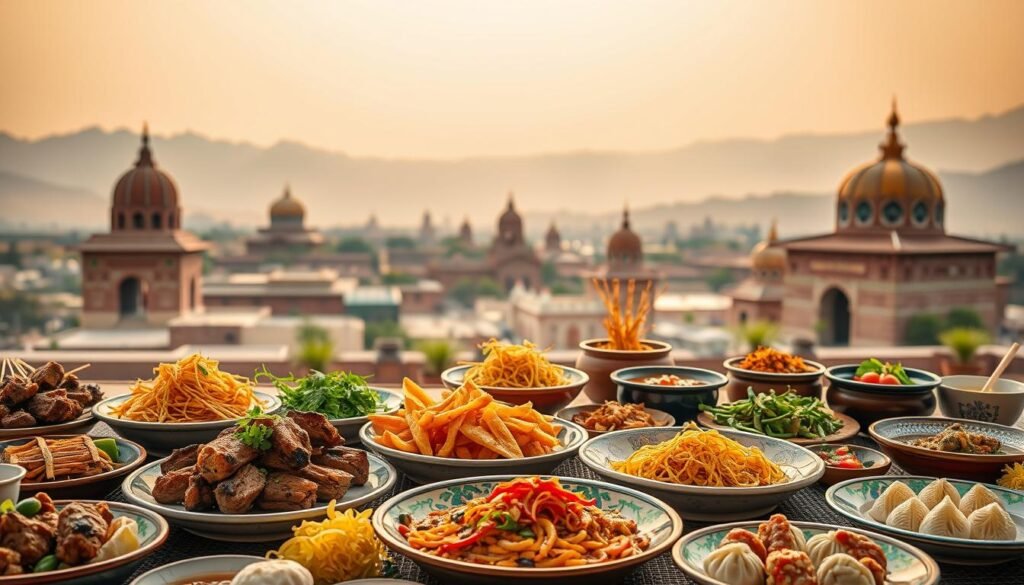
When East Meets Global Palates
Silk road fusion food is all about new pairings. One chef mixes noodles with French-inspired sauces; another makes herbal cocktails with goji and gooseberry. These dishes are more than just fusion—they’re conversations through time. For those wanting to try these, Epicurean Escape’s culinary tours are a great way to explore.
The art of reinvention here is about listening and asking new questions. A taste of date-stuffed steamed buns wrapped in edible flower leaves shows tradition can grow in new ways without losing its essence.
Why American Palates Will Appreciate Dunhuang’s Balanced Flavors
Exploring Dunhuang’s markets, you see how its dishes blend elements that appeal to Western tastes. Chinese food American palate compatibility shines in cumin-spiced lamb. It combines Sichuan spices with Mediterranean herbs, familiar to many. This Gansu cuisine for Americans opens a door to Chinese cooking, welcoming those new to it.
- Flavor balance: Sweet, savory, and herbal notes coexist, avoiding the fiery heat of Sichuan or numbing .
- Approachable textures: Crisp vegetables and tender meats mirror American preferences for fresh, recognizable ingredients.
- Transparent ingredients: Dishes like lychee pork showcase quality proteins and herbs, aligning with today’s farm-to table values.
| Dunhuang Dish | Western Parallel |
|---|---|
| Lamb with cumin | Moroccan tagine |
| Wheat ear bread | Italian focaccia |
| Lotus root soup | French vegetable bisque |
Dunhuang’s approachable Chinese cooking bridges traditions through cross-cultural food appreciation. Its recipes respect heritage while being easy to enjoy. Each bite is a story, yet it’s also simple to love for both travelers and home cooks.
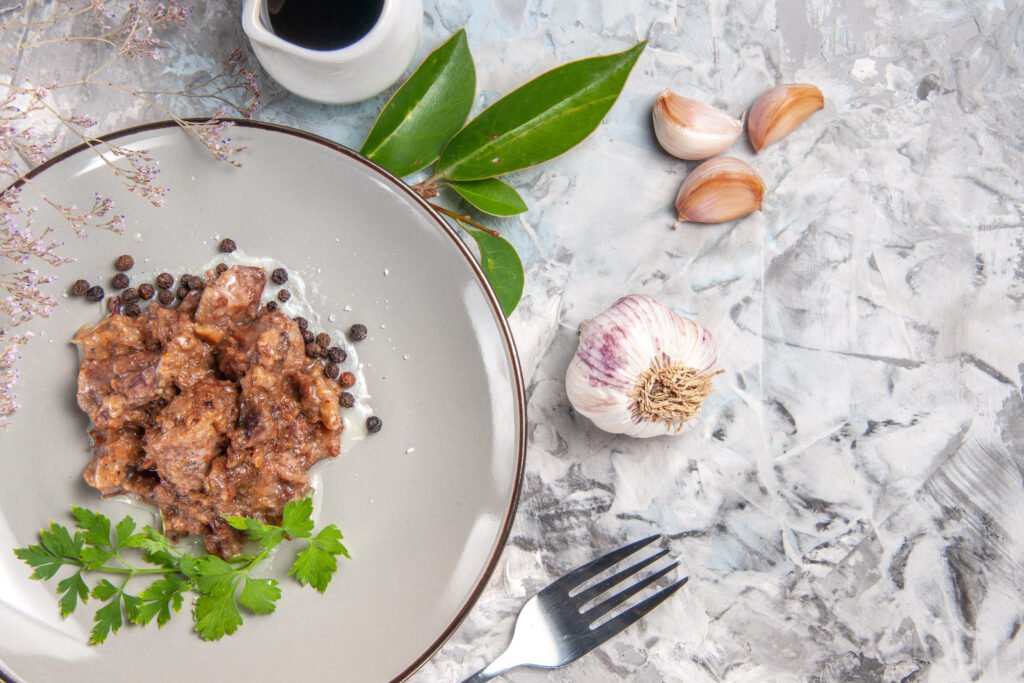
Conclusion: Carrying the Essence of Dunhuang’s Culinary Heritage Home
Your time in Dunhuang shows you how deeply food connects you to the past. The Silk Road’s influence lives in every dish—from lamb kebabs to tea-infused soups. Each flavor tells a story of the desert, turning your journey into something truly unforgettable.
By bringing home Sichuan peppercorns or learning to make hand-pulled noodles, we can share Dunhuang’s culinary art. Even in Western kitchens, we can recreate the balance of cumin and star anise. This shows how food can bridge cultures.
As you leave Dunhuang, you take more than just memories. You’ve learned that scarcity sparks creativity—from preserved dates to slow-cooked stews. The sounds of bustling bazaars and the scent of communal meals remind you that food is its own language. And every time you make lamb stew or sip green tea, you’ll remember the dunes of Gansu and the cooks who inspired you.
